How to quickly and easily remove an air lock from a heating system?

An airlock is excess air that occupies a pipe diameter or most of it.
As a result of the appearance of an air barrier heat stops flowing further along the circuit.
There are several ways to get rid of an air lock in the heating system.
Content
- Where does the airlock come from?
- How is it formed?
- How to determine the place where air appeared
- How to bleed air from an apartment building
- Removal in a house with an autonomous heating system
- If it enters a closed-type natural circulation system
- With forced circulation
- Air separator
- Useful video
- If this did not help to remove the VP
Where does the airlock come from?
Reasons:
- there are pipes or radiators along the contour damage;
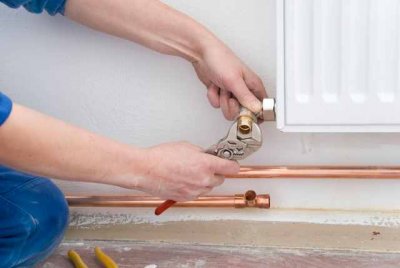
- a mistake was made at the stage installation or even design (most often there is an incorrect calculation or execution of the pipe slope);
- low pressure (no matter the reason) - the space that is not occupied by water is occupied by air;
- incorrect system start into operation at the end of the summer season (a common mistake is filling the circuit with warm or hot coolant);
- fast heating water to maximum temperature;
- absence or malfunction Automatic air bleed devices from pipes;
- incorrect connection of "warm floor" — due to the complex circuit and small diameter of the pipes, this part of the circuit is the most problematic to connect.
How is it formed?
If the coolant is poured incorrectly (for example, from the top point), turbulence is formed: Water tends to go down and air to go up. During the movement, the liquid displaces the air, if there are suitable irregularities in the inner surface, it stops in them. Gradually, the volume of trapped air increases.
Why is it important to get rid of it in time?
Even a small amount of air in the system is highly undesirable, although a plus can be found here too: the appearance of a plug - system malfunction signalBut there are many more problems:
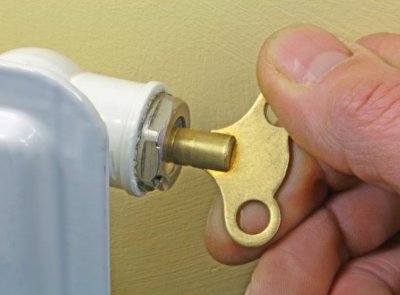
- weak heating radiators or lack thereof;
- noise, vibrations — create noticeable discomfort;
- the combination of air and hot coolant leads to the emergence unwanted chemical processes, which leads to additional layers on the internal surfaces;
- some chemical processes entail increased acidity within the system, which creates conditions for corrosion;
- If there is a circulation pump in the system, then its operation may go idle, this will lead to breakage.
How to determine the place where air appeared
The easiest method to detect a traffic jam is hearingYou need to carefully tap the battery - the empty space will respond louder.
You can find suspicious places in advance by degree of heating: where the coolant does not pass, there will be areas with low temperatures
Both ways are not very accurate. The coolant may not pass due to a blockage of dirt and rust. This problem is solved by flushing.
How to bleed air from an apartment building
Air can be released in the following ways.
Bypassing the riser to discharge
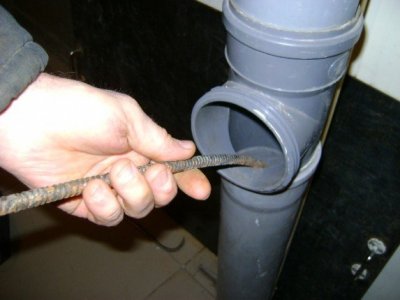
In progress housing and communal services employees. To release air, devices are installed on the upper floors.
If it is not possible to use them (the apartment is closed, no one is home), you can bypass from the basement - for a two-pipe system.
The risers must be provided with dumpers. They are located after the valves. If available, you should stock up on a ball valve with a diameter similar to the plug.
Process:
- The risers are blocked (valves).
- On one of them very slowly and carefully the plug is unscrewed. No more than 1-2 turns, so that you can feel the water pressure. Before turning further, you need to wait until the pressure subsides.
- It is screwed into place of the plug ball valve with seal.
- Installed resetter opens completely, then water is supplied to the second one.
For a successful result, you need to look in advance at how the heating system layout of the house is made.
It is optimal if the radiators are located along the circuit on the supply riser, then installing a second one with a drain on the return line will solve the problem: there will be no air. When heating devices are distributed over two risers, there is no guarantee of a 100% result.
If the problem is not solved, the same actions are performed in the opposite direction. To do this, the ball valve is moved to the second riser.
Important! Screw valves do not tolerate the direction of water flow that does not correspond to the arrows on the body. If this is the case, you will have to reset the entire system.
The usual heating system layout is lower. The supply and return pipelines are located in the basement. The connection between them is made through a jumper on the top floor.
How to clear a plug using a Mayevsky tap
The device is cylindrical and small in size. It is installed on top of the radiator if there is space for it in the niche. In one-story houses All radiators are equipped with it.
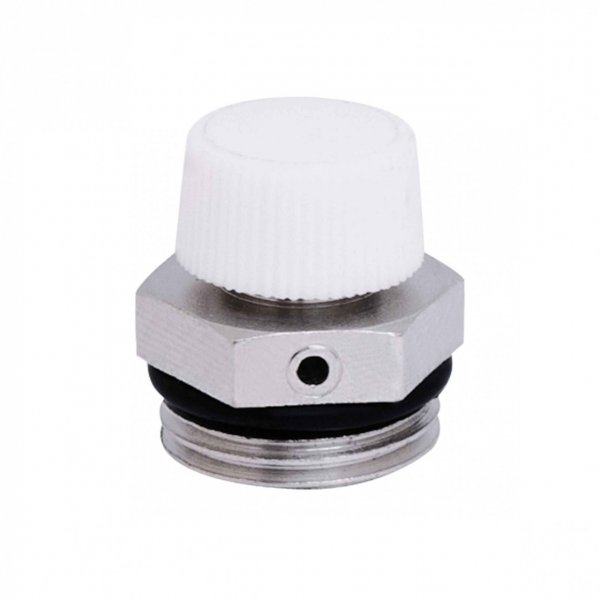
Photo 1. Mayevsky tap for bleeding radiators, model 1/2 SL No. 430, equipped with a sealing ring, manufacturer - "SL".
If the system is vertical, the device is installed on the top floor, to release air from the entire riser at once.
Additionally, the Mayevsky crane is installed on heating devices located below the common lower connection point to the riser. Sometimes - on heated towel rail in the bathroom. It is placed vertically through a tee, which allows you to change the location of the device axis.
The Mayevsky crane is very easy to operate: to release air, the valve opens and then closes. If this does not solve the problem of the radiator heating, then it will have to be cleaned.
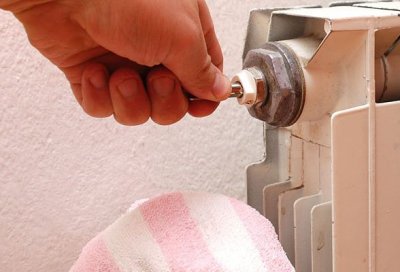
- Before releasing air the circulation pump is switched off, if the water flow is forced.
- All objects located close to the radiator, are moving away.
- It is placed under the valve basin or bucket.
- With a screwdriver or a key begin to turn until a hissing sound appears.
- When the water appeared, the tap are closing.
Remove with a regular ventilator
The valves must be in the highest points of the contour. Air release occurs according to the same algorithm as with the Mayevsky tap.
Expel through the plug
This method is used if nothing special is installed.
To use the plug, you need to:
- turn off riser;
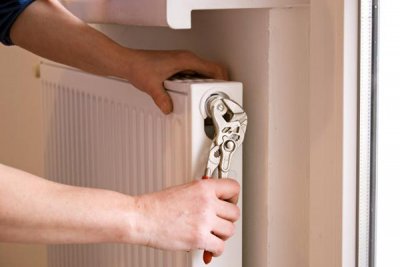
- put it under the plug bucket or other container;
- If the plug is covered with paint, it soften with solvent;
- with an adjustable wrench carefully and slowly turn the plug until a hissing sound appears; it is important not to miss this moment, because you cannot open the plug completely;
- after the hissing stops, wait appearance of liquid;
- the plug is screwed in back, if necessary, it can be compacted.
Important! All manipulations are done slowly, without sudden movements.
Removal in a house with an autonomous heating system
The generation of the gaseous form of the coolant begins when it enters the pipes. The process intensifies when heated, the air is collected under the "ceiling" of the contour.

Therefore, the heat source is always switched on only after the circuit has been filled and excess air has been released.
Removing gas invariably entails pressure drop and decrease in the amount of coolant — during the process it is necessary to keep the pressure and feed supply under control.
Raise pressure and temperature
Pressure reduces the rate of gas release from a liquid (at constant temperature).
In the vertical system there is upward movement of air, but it can move down with the water, “hanging” in the flow.
Reference! In horizontal sections of the circuit, in pipes with a slope, gas occupies the upper position. At high water speed, air breaks up and begins to move along unpredictable trajectories. Therefore, filling the system must occur slowly.
By manipulating the pressure, you can fine-tune the system. Normal natural pressure - 1 Bar. As the circuit fills, the pressure begins to rise.
If heating is added to this, the coolant expands, which leads to an increase in pressure. Air begins to separate from the water more active.
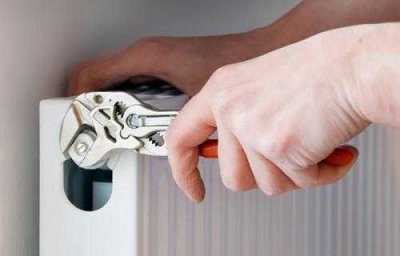
If the system is designed correctly, after filling it with coolant, air will begin to be removed through a system of automatic valves or it will be removed manually.
The drop in pressure indicates coolant leak, increase - o airlock (it acts like a constriction in a pipeline).
Given the interaction characteristics of air and water, they can be used to combat air locks. If the location of the air pocket cannot be determined, a short-term rise in temperature and pressure will cause the air in the system to redistributeThe plug will either move to a place where it can be removed, or the air will escape through automatic valves.
If it enters a closed-type natural circulation system
This type of heating system involves removing air through an expansion tank installed in the highest position.
- TO overflow pipe A hose is attached, allowing liquid to be poured out.
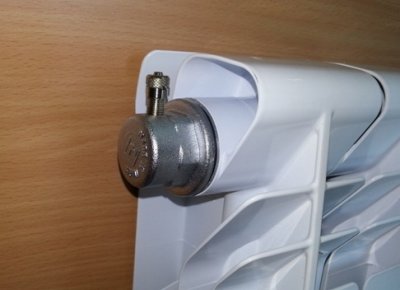
- Opens low pressure feed, turns off when water starts flowing from the hose.
- Next, the air is released from each battery. (plugs, Mayevsky tap).
- After this, the coolant is added to the system. (about 2/3 of the boiler volume).
Then the boiler is turned on, the radiators should start heating up. If necessary, the process is repeated. When the slopes of the pipeline are observed, the air comes out on its own. If this does not work, the coolant can be heated, then the air will come out more actively.
With forced circulation
To drain a system with forced circulation you will need: two people. The second one makes sure that the pressure does not drop. below 1 Bar (pressure is generated by a pressure testing pump or through feed from the water supply).
Important! Initially, the coolant must be coldHeating is switched on after the entire heating main is filled.
- The whole thing opens up shut-off valves, excluding drains.
- Overlapping all radiator valves, only the last radiators in the branches remain open.
- After starting the water supply, they are filled main lines, boiler and expansion tank. At this stage, air comes out of the air vent at the top of the circuit and the safety group valve (it is recommended to install it for boilers with any type of fuel).
- Next opens taps on the first battery from the boiler, air is released through the Mayevsky valve, then the valves are closed.
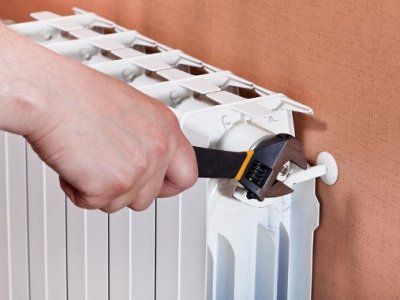
- Are being filled alternately all radiators.
- From the circulation pump the air is released.
- After the entire circuit is filled, the pump is turned on and the heat generator is activated. Pumping the circuit takes about 15 minutes.
- After heating the main lines, the taps on the radiators alternately open, and you need to release the air from each one again.
At the end of the procedure, the pressure should not exceed 2 BarThe underfloor heating system is filled last.
If there are several branches, they are filled in alternately, air comes out through the manifold valves. The filled branch closes, heating begins after filling the entire system.
To simplify the process of squeezing air out of the system, you should ensure that you have:
- Mayevsky cranes on radiators, if the heating main runs below the batteries;
- automatic valves, when the pipes pass higher.
This is a complex process that requires quite a lot of time. However, you should not rush when doing the work - haste and inattention can lead to the appearance of wandering airlock. It will take much more effort to fix this problem.
Air separator
A sophisticated and efficient device designed for autonomous systems, especially vast extent.
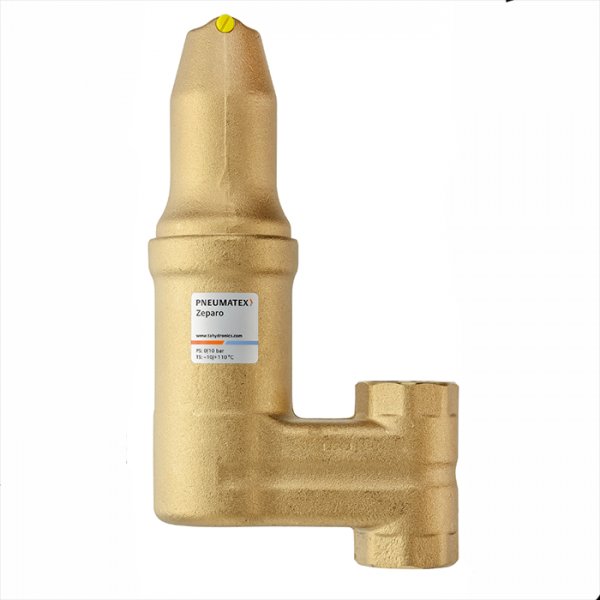
Photo 2. Air separator model ZUVL 20 for vertical pipeline, manufacturer - "IMI Pneumatex".
Takes air from the water and removes it automatically. There is one on top air vent. Double-action separators are produced - for catching air and impurities. In this case, the device is equipped with a valve for removing accumulated impurities and particles.
There is a mesh inside the device that causes turbulence and the appearance of air bubbles.
Useful video
Watch the video to learn how to remove an air lock from your heating system.
If this did not help to remove the VP
If after technologically correct filling of the system and actions to remove air the pressure does not stabilize, and the heating continues uneven, I'll have to check, tightness systems. Air locks are also caused by errors made at the installation stage: incorrect slopes, the presence of corners in the pipeline.








